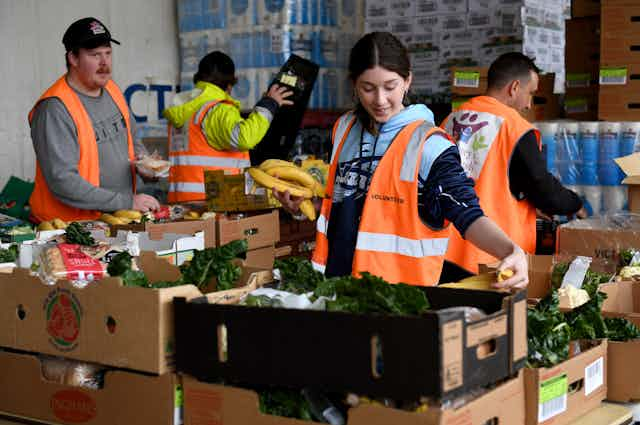The COVID-19 pandemic hit volunteering very hard. By June 2021, volunteer numbers in Australia had fallen by 37% from the start of the pandemic.
In the first two years of the pandemic, around 1.86 million people left volunteering, according to Volunteering Australia. Last year, 26.7% of the population did formal volunteer work. That’s well down from the pre-COVID level of 36% in 2019.
Many depleted volunteer services are now feeling the strain of increasing demand due to the cost-of-living crisis. They are also facing the compounding effects of an ageing population, the ongoing impacts of COVID-19, unaffordable housing and the mental health epidemic.
To try to rebuild the ranks of volunteers, Volunteering Australia recently released a government-funded national strategy. It outlines 11 strategic objectives for the next ten years to secure the future of volunteering in Australian communities.
The strategy is based on input from across the volunteering sector. Some 83% of organisations reported they need more volunteers. As the strategy observes, volunteering in Australia is facing a sustainability crisis.
Read more: Loss of two-thirds of volunteers delivers another COVID blow to communities
COVID accelerated a long-term decline
Australia’s most populous states, New South Wales and Victoria, have suffered the biggest declines in volunteering. This is likely linked to the extent of disruptions by COVID lockdowns in those states.
Volunteering rates in rural Australia remain higher than in metropolitan areas. Research shows this is likely driven by need. Rural areas often have no alternative to the services volunteers provide.

Work and family commitments are the most common reasons for not volunteering. For those who had left volunteering, perceived over-regulation – the “red tape” – had caused many to step away.
Volunteers are also having to re-assess if they can afford to continue. Many have to cover out-of-pocket expenses, such as travel costs, meals, training and, increasingly, specialist software for their volunteering activities. Volunteering Victoria has found the costs per volunteer average $1,500 a year.
Those volunteers face a difficult choice. Most of them gain great personal satisfaction from volunteering and helping others.
It’s also a critical social outlet. Volunteering is a way to engage with people who share common interests and values.
The national strategy also identifies a significant mismatch between the volunteering opportunities being offered and what non‑volunteers are interested in. This applies to both the types of organisations and the types of roles.
Read more: How helping others during major life transitions could be a path to greater well-being
Informal volunteering is on the rise
While more and more people are moving away from volunteering in formal organisations, research has shown informal volunteering is increasing. The strategy reports just under half the population (46.5%) took part in informal volunteering in 2022.
This form of volunteering is not associated with a volunteer organisation. Informal volunteering can include anything from organising local garden clean-ups and running a street library to helping out neighbours, updating Wikipedia pages and running community “buy nothing” pages on Facebook.
Informal volunteering may take as much time as formal volunteering. However, its informal nature allows people to be more flexible about when they offer their time. They are also able to pick and choose activities that best suit their interests and skills.
Read more: Volunteer on a dig for the thrill of digging up the past (you'll also learn to hate buckets)
Informal and local-scale volunteering is not new, of course. But the COVID pandemic did result in an increase in informal volunteering. Up to half of all Australians did it in some form.
Throughout the pandemic stories emerged of local communities rallying together to support each other. There were ad-hoc social events, community choirs, food drives and other local initiatives. Philanthropic funding helped support these informal local efforts.
The growth of informal volunteering is a “good news” story. More people are getting involved in a more diverse range of activities, in ways that fit with their busy lives.
However, the need to curb the decline in formal volunteering remains pressing. Formal volunteering underpins essential services such as emergency work and social care and support. Sporting and cultural events also rely on regular, volunteer-provided services.
Read more: 'Time is their secret weapon': the hidden grey army quietly advancing species discovery in Australia
So what can volunteer organisations do?
It is not a lack of goodwill that is driving the decline in formal volunteering; the growth of informal volunteering clearly attests to this.
To reverse the decline, researchers argue the sector has to innovate to improve its diversity and inclusiveness.
More flexible models of volunteerism are needed too. Organisations should make greater use of remote engagement via the internet and hybrid collaboration. For example, having meetings online enables participation by volunteers who are not necessarily located in the same place.
The National Strategy for Volunteering 2023-2033 makes clear the quality of volunteers’ experience of this work is critical to attracting and retaining more volunteers. To improve this experience, volunteering organisations need to develop avenues for engaging diverse cohorts and provide opportunities for ad-hoc and alternative modes of volunteering.
Volunteering Australia also highlights that volunteers are not looking to replicate the experience of paid work. While they might draw on knowledge and skills from their workplace, volunteering is about more than simply the labour they are providing.
To sustain volunteering in Australia, it is essential to recognise and value the intrinsic desire that volunteers have to make a difference. It’s equally essential to make it easier for people to undertake diverse forms of volunteering. These options will better enable them to balance family, work and volunteering commitments.
The growth of informal volunteering shows Australians are still willing to volunteer, if volunteering can fit in with the other demands of their busy lives.

